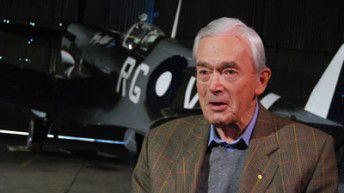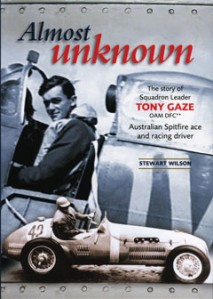

Often in sport we talk about the courage shown by an athlete under extreme pressure and elevate them to hero status.
This week’s ‘Where are they Now?’ focuses on a real hero. As Australia and all of its sports fans closely watch to see if Mark Webber can win the F1 crown, Speedcafe.com.au contacted the very first Australian to race in a Formula One event to talk about his racing career.
Tony Gaze is a hero in every sense of the definition. Gaze was a Squadron Leader in the RAF during World War Two, flying in the world famous Tangmere wing, which was known for its exploits in the Battle of Britain, the evacuation of Dunkirk, D-Day and the Normandy campaign.

He flew 485 sorties across Europe and received the Distinguished Flying Cross (DFO), which is awarded for ‘acts of valour, courage or devotion to duty whilst flying in active operations against the enemy’, on three occasions and was given ‘ace’ status for his tally of 11 destroyed aircraft, three shared, four probable and four damaged.
Before the war Gaze showed an interest in motorsport, but wasn’t able to get serious until well after its completion. Even then there was not a lot of motorsport happening in Europe at this time. As the world worked to clean itself up, Gaze, who remained in the Royal Air Force for a time after WW2, turned his attention back to motorsport.
“I first raced before the war while I was in England, at a place near Cambridge,” Tony Gaze explained to Speedcafe.com.au
“I joined a local club and did some hill climbs. I stayed in the RAF after the war and ended up doing some more hill climbs; there was no organized racing at the time, so we just did what we could.”
Gaze raced in Formula One in 1952, the year Italy’s Alberto Ascari won the title. These days anyone with racing talent, determination and a full wallet can find themselves driving a Formula One car, back in the early 50’s it was a case of knowing everyone down pit lane and patiently waiting to be ‘invited’ by the sport to race.
“I’d returned to Australia, drove in some races and broke some records,” Gaze said.
“I was getting letters from the European based drivers to come back to England to race.
“I was working for my father at the time, which is never a good thing, so I ordered an F2 car and went racing.
“F2 was the way to go back then. In F2 you could race almost every weekend, while in F1 there were only six or so races.
“All the F1 drivers competed in F2, so I knew everyone.
“I didn’t stand much of a hope, racing against all the works teams, so I returned to Australia.
“Then I received an invitation to race Formula One, that’s how it was done back then, they offered me some money and I did it.”
Gaze’s F1 career only amounted to four rounds. He debuted at the Belgian Grand Prix (the first time an Australian ever raced in F1) and raced at the British and German events. His fourth and final GP was the Italian, where he failed to qualify. His best result was 15th in Belgium and he had two further retirements.
Even now, Gaze has strong memories of the famous long circuit at Nürburgring.
“I liked it, it was like Bathurst only longer,” Gaze said.
“You never got a lot of practice there because a lap took nine minutes, but I knew it well from the books that I’d read, it was frightening but wonderful at the same time.
“I remember there being a hedge the whole way around.
“I didn’t realize that photographers used to hide in the hedges to get the best photos, on my first couple of laps I gave some of them the fright of their life!”
Apart from racing, Gaze was also involved in the establishment of the Kangaroo Stable, a team he created to help Australians race in Europe.
“We went over (to Europe) to race the long distance events,” said Gaze.
“We got drivers like Jack Brabham involved and had our first race in the South of France in 1954, but the team quietly folded after the Le Mans tragedy in 1955 (where many people were killed and 120 injured during an incident during the race).
“After that everything was cancelled, organisers eventually allowed two litre engine racing only and our cars had three litre engines. We ended up selling the cars and heading home.”
Gaze can also claim to have had a helping hand in creating what is now called the Goodwood Festival of Speed.
During the war, Gaze was based at an air force base called RAF Westhampnett, which was within the Goodwood estate owned by the Duke of Richmond.
“Goodwood Estate had a large airfield that would get occasional use prior to the war,” said Gaze.
“During the war a perimeter track was built to assist the RAF service vehicles. If you owned a sportscar, I had an MG, you’d go for a drive around this … we always thought it would be good for racing.
“After the war I was having a drink with the Duke of Richmond, who was president of the local junior car club, he was looking for a track and I pointed out that there was one on his property.
“He was reluctant to use it because of the noise; he was concerned for the neighbours, but eventually saw the merit in using it.
“It is interesting to see over 130,000 people now travel to Goodwood to watch historics race given what it was all those decades ago.”
Gaze decided to retire from racing after his wife expressed her worry towards his racing. He kept to his word and retired as soon as it was asked of him and turned his focus to …. gliding.
“I gave up racing to please my wife,” Gaze said.
“I had had a few bad accidents, one where I was upside down on the roof while the car was on fire, so when she asked that I give it up, I did.
“I sold my cars to Lex Davison and moved on.
“I was asked what I was going to do, to which I had no idea, so a friend said that I should try my hand at gliding. I thought why not.
“I was doing reasonably well at it, so I decided I might as well get serious. I entered a competition and then went to the World Championships in Germany.
“I made a mess of it on the first day of competition. I was supposed to finish in Cologne, but didn’t quite get there. I had no idea where I was.”
After giving away competitive racing and gliding Gaze retreated to rural Nagambie, not far out of Melbourne, were he focused on farming. He raised cattle and had crops.
At a sprightly 90 years of age, Gaze doesn’t get to many races, but tries to get to the Australian Formula One Grand Prix in Melbourne, where he can look at the cars and watch his beloved grandsons, Alex and Will Davison race.
“I go to races where I can,” said Gaze.
“I went to Europe to watch Alex and Will race, but the health doesn’t allow that sort of thing anymore.
“I watch V8 races on television, I’m glued to it. I like to see how they are going.”
As for Formula One, he still watches the odd race, but is not as in to it as he once was. That said, he believes that Webber has a good chance to win the Championship.
“Races these days are mostly won in the pits,” said Gaze.
“If everything goes well he stands a very good chance to win.
“I’d certainly like to see him win it.”


















